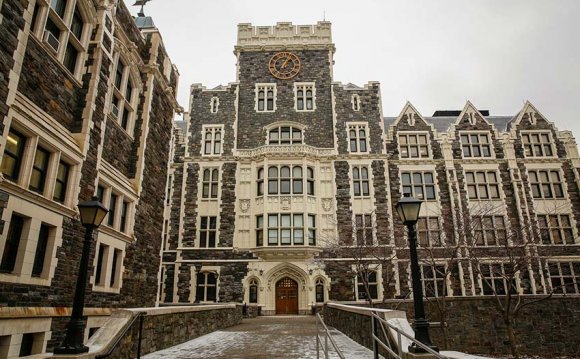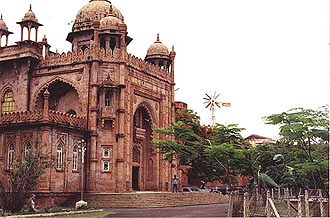
|
Characteristics of Gothic Architecture Gothic art evolved out of Romanesque art and lasted from the mid-12th century up to the late 16th century in some areas of Germany. Architecture was the main art form of the Gothic, and the main structural characteristics of Gothic architectural design stemmed from the efforts of medieval masons to solve the problems associated with supporting heavy masonry ceiling vaults (arched roofs) over wide spans. The problem arose because the stonework of the traditional arched roof exerted a tremendous downward and outward pressure against the walls upon which it rested, which often caused a collapse. Up to and including the preceding period of Romanesque architecture (c.800-1150), building designers believed that vertical supporting walls had to be made extremely thick and heavy in order to counteract and absorb the vault's downward and outward pressure. But Gothic designers solved this problem around 1120 with several brilliant innovations. Ribbed Vaulting: Flying Buttresses: Pointed Arch First and most important, they developed a ribbed vault, made up of intersecting barrel vaults, whose stone ribs supported a vaulted ceiling of thin stone panels. Not only did this new arrangement significantly reduce the weight (and thus the outward thrust) of the ceiling vault, but also the vault's weight was now transmitted along a distinct stone rib, rather than along a continuous wall edge, and could be channelled from the rib to other supports, such as vertical piers or flying buttresses, which eliminated the need for solid, thick walls. Furthermore, Gothic architects replaced the round arches of the barrel vault with pointed arches which distributed the vault's weight in a more vertical direction. To put it simply, until Gothic builders revolutionized building design, the weight of the roof (vault) fell entirely on the supporting walls. As a result, the heavier the roof or the higher the roof, the more downward and outward pressure on the walls and the thicker they had to be to stay upright. A Romanesque cathedral, for instance, had massively thick continuous walls which took up huge amounts of space and created small, dim interiors. In contrast, Gothic architects channelled the weight of the roof along the ribs of the ceiling, across the walls to a flying buttress (a semi-arch), and then down vertical supports (piers) to the ground. In effect, the roof no longer depended on the walls for support. As a result the walls of a Gothic cathedral could be built a lot higher (which made the building even more awesome), they could be a lot thinner (which created more interior space); they could contain more windows (which led to brighter interiors and, where stained glass art was used, more Biblical art for the congregation). All this led to the emergence of a completely new type of cathedral interior, whose tall, thin walls gave the impression of soaring verticality, enhanced by multi-coloured light flooding through huge expanses of stained glass. Its exterior was more complex than before, with lines of vertical piers connected to the upper walls by flying buttresses, and large rose windows. As the style evolved, decorative art tended to supercede structural matters. Thus decorative stonework known as tracery was added, along with a rich assortment of other decorative features, including lofty porticos, pinnacles and spires. Master Masons
History and Development of Gothic Architecture Three phases of Gothic architectural design can be distinguished: Early, High, and Late Gothic. Early Gothic (1120-1200) The fusion of all the above mentioned structural elements into a coherent style of architecture occurred first in the Ile-de-France (the region around Paris), whose prosperous inhabitants had sufficient resources to build the great cathedrals that now epitomize Gothic architecture. The earliest surviving Gothic structure is the Abbey of Saint-Denis in Paris, begun in about 1140. Cathedrals with similar vaulting and windows soon appeared, beginning with Notre-Dame de Paris (c.1163-1345) and Laon Cathedral (c.1112-1215). A series of four distinct horizontal levels soon evolved: ground-level, then tribune gallery level, then triforium gallery level, above which was an upper, windowed level called a clerestory. The pattern of columns and arches used to support and frame these different elevations contributed to the geometry and harmony of the interior. Window tracery (decorative window dividers) also evolved, together with a diverse range of stained glass. The eastern end of the early Gothic cathedral consisted of a semicircular projection called an apse, which contained the high altar encircled by the ambulatory. The western end - the main entrance to the building - was much more visually impressive. Typically it had a wide frontage topped by two huge towers, whose vertical lines were counterbalanced by horizontal lines of monumental doorways (at ground level), above which were horizontal lines of windows, galleries, sculpture and other stonework. Typically, the long outside walls of the cathedral were supported by lines of vertical piers connected to the upper part of the wall in the form of a semi-arch known as a flying buttress. This early style of Gothic architectural design spread across Europe to Germany, England, the Low Countries, Italy, Spain and Portugal. For an interesting comparison with Eastern architecture, see: the 12th century Angkor Wat Khmer Temple (1115-45) and the 11th century Kandariya Mahadeva Temple (1017-29). High Gothic (1200-80) "Rayonnant" On the Continent, the next phase of Gothic building design is known as Rayonnant Gothic architecture, whose English equivalent is referred to as "Decorated Gothic". Rayonnant Gothic architecture was characterized by new arrays of geometrical decoration which grew increasingly elaborate over time, but hardly any structural... |
RELATED VIDEO




 Venetian Gothic is a term given to an architectural style combining use of the Gothic lancet arch with Byzantine and Moorish architecture influences. The style originated in 14th century Venice with the confluence of Byzantine styles from Constantinople, Arab...
Venetian Gothic is a term given to an architectural style combining use of the Gothic lancet arch with Byzantine and Moorish architecture influences. The style originated in 14th century Venice with the confluence of Byzantine styles from Constantinople, Arab...








